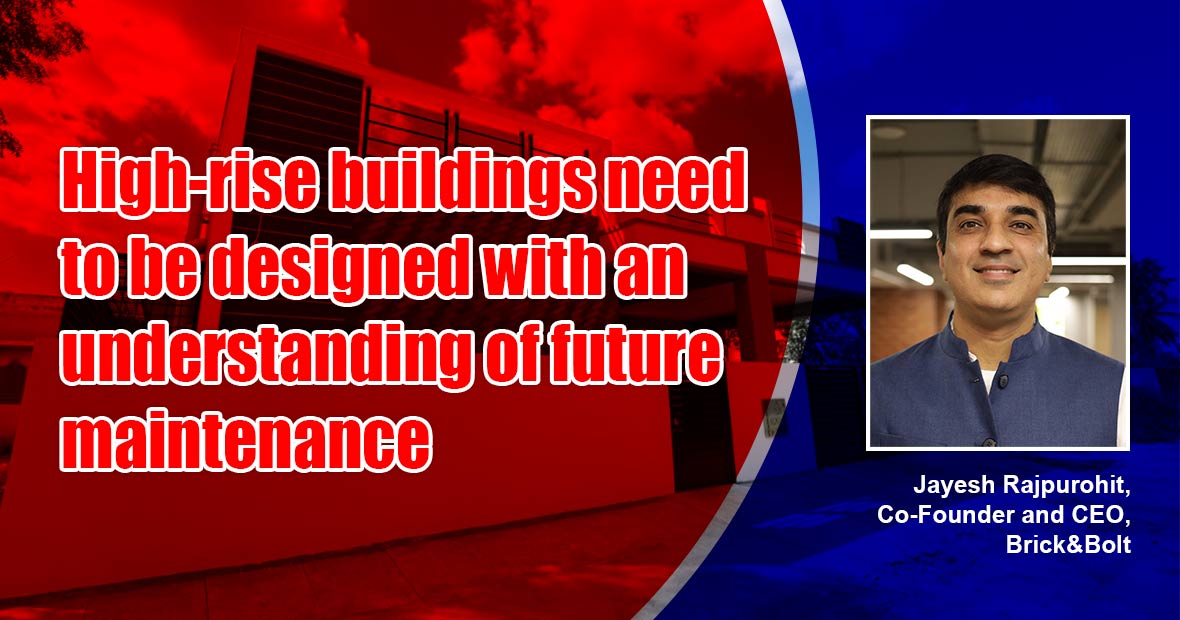High-rise buildings need to be designed with an understanding of future maintenance

Buildings that have come into existence due to modern construction methods are already planned for maintenance, the maintenance required in such buildings is preventive maintenance using tools and technology wherever possible says Jayesh Rajpurohit, Co-Founder and CEO, Brick&Bolt.

What kind of maintenance is required for the existing buildings which have come into existence as a part of the modern construction methods?
Buildings that have come into existence due to modern construction methods are already planned for maintenance needs in terms of layout and design of services and choice of durable materials laid out with the right construction methodology. The maintenance required in such buildings is preventive maintenance using tools and technology wherever possible. Modern buildings with BIM (Building Information Management) based maintenance are very common. The design of all services is modular and sensors relay the health of each module in a fire safety system or a pressurized water supply system or a sewage treatment plant to a central database and continuous monitoring of this data and automatic shut off and alerting from the BIM system to address the issues are very frequently being used.
Unlike a regular building when it comes to high-rises, what kind of maintenance measures are most desired to keep it in good health?
High-rise buildings need to be designed with a deep understanding of future maintenance requirements. Shafts for the services, for example, need to be accessible easily and enough maneuverability is needed to service pipe joints, connections, elbows and bends. A proper maintenance plan and a property management service provider are necessary to frequently follow predefined SOPs across all aspects of maintenance like housekeeping, landscape maintenance, maintenance of MEP services and administering shared services like piped gas, heating and cooling systems, STP and WTP. A reactive approach to attending to problems when discovered will not help, especially in high rises. Proper preventive maintenance is the only way to keep high rises in good health.
When it comes to infrastructure audits, what should be the frequency of this exercise when it comes to infrastructure facilities used by the public, what are some of the key parameters to be looked at?
A plan for any infrastructure development facilities program should improve the existing infrastructural facilities and help create newer durable public assets and quality-oriented services in cities & towns.
The plan should also work on enhancing public private-partnership in infrastructure development and promote planned and integrated development of towns and cities The objectives of any infrastructure audits for facilities used by the public need to be very clear. These must include measures to evaluate if:
- There was proper planning for implementation of the scheme and the execution was economical and effective
- Adequate funds were provided, released in time, and utilized economically for the creation and maintenance of assets;
- Agenda for reforms in Urban Governance was implemented; and
- Mechanism for monitoring and evaluation was adequate and effective.
The frequency of such audits is a very broad area. This depends on the extent and scope in which these audits are carried out.

What are some of the modern construction methods developers and builders need to adopt in order to create robust buildings?
The most important aspect in modern construction methods developers and builders need to adopt in order to create robust buildings is to understand the new normal in construction. There are multiple facets to this. Based on a report by McKinsey and Company titled ‘The Next Normal in Construction,’ Some major shifts are underway and they will radically change the way construction projects are delivered. A combination of sustainability requirements, cost pressure, skills scarcity, new materials, industrial approaches, digitalization, and a new breed of players looks set to transform the value chain. The shifts ahead include productization and specialization, increased value chain control and greater customer centricity and branding. Consolidation and internationalization will create the scale needed to allow higher levels of investment in digitalization, R&D and equipment, and sustainability as well as human capital.
Brick&Bolt, India’s number one tech enabled construction company is disrupting the construction industry by bringing together a combination of tech, predictability and scale in construction. As a leader in the ConTech space, here are a few suggestions to builders and developers for creating robust buildings of the future:
- Introduce new production technology to enable industrialization and shift toward off-site production.
- Make the shift towards new material technology by switching to new, light-weight materials and improve logistics
- Digitalization of processes and products and shift toward more datadriven decision making
While going digital, companies also need to focus on the following aspects:
- Operations – Create smart buildings and infrastructure
- Design – BIM (Building Information Management Systems) Pre detection of issues/delays/ approvals that may arise during construction so that issues are not detected at run time but at setup time and are fully resolved when work begins.
- Construction and production – Switch to BIM-based project management
- Channels- Setting up digital sales channels and distribution/logistics enabling off-site production and onsite assembly for the most part.
What are some of the key materials which will forge the buildings of the future?
The key materials that will forge the future of the building industry will aim at sustainability as a major aspect. Global warming, the ongoing pandemic, carbon footprints and a general strengthening of regulation around pollution etc. will ultimately provide an impetus to sustainable methods of construction and in the larger scheme sustainability itself. The latest research ongoing in the field of construction has led to some amazing improvisations. Here are some of them:
- Cross-laminated Timber will be used widely in construction
- Prefabricated Modular Construction Using LGSF (Low-Grade Steel framework) is already being used extensively
- 3D Printing of Structures using Concrete will be in common use
- 3D Printed Graphene
- Memory Steel
- Zero Carbon Cement
- Self-healing Bio-Concrete containing certain bacteria that will cause cracks and need for sealing joints a thing of the past
- Artificial Spider Silk
- Air-purifying facades
6
Cookie Consent
We use cookies to personalize your experience. By continuing to visit this website you agree to our Terms & Conditions, Privacy Policy and Cookie Policy.









